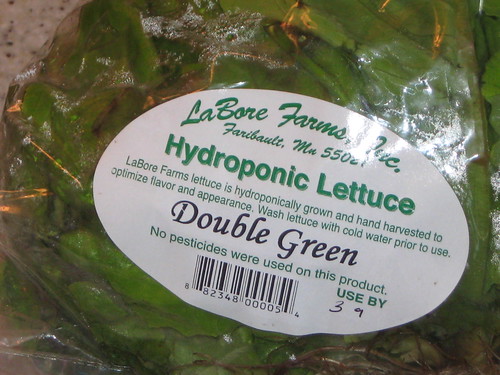 Like any blogger I keep an ongoing list of potential post topics, which includes recipes I've used, products I like, and restaurants that are worth writing about, for better or worse. Around the time of the RNC in 2008, rumors began to circulate about a Bulldog opening in St. Paul. Most people I talked to were enthusiastic, as the Bulldog NE has been a huge hit across the river, offering the well-needed combination of a unique beer list and thoughtfully prepared bar food, emphasizing high quality ingredients such as humanely raised Midwest Wagyu beef - more about this later. As a St. Paul resident, blogging about the new location was a no-brainer, as such a bar doesn't really exist in this city (the Muddy Pig comes close for beer, but the food doesn't hold a candle to Bulldog NE).
Like any blogger I keep an ongoing list of potential post topics, which includes recipes I've used, products I like, and restaurants that are worth writing about, for better or worse. Around the time of the RNC in 2008, rumors began to circulate about a Bulldog opening in St. Paul. Most people I talked to were enthusiastic, as the Bulldog NE has been a huge hit across the river, offering the well-needed combination of a unique beer list and thoughtfully prepared bar food, emphasizing high quality ingredients such as humanely raised Midwest Wagyu beef - more about this later. As a St. Paul resident, blogging about the new location was a no-brainer, as such a bar doesn't really exist in this city (the Muddy Pig comes close for beer, but the food doesn't hold a candle to Bulldog NE).
Anyone who has eaten at the Bulldog NE knows that their burgers are special. As explained on the menu, all burgers are made from pasture-raised Wagyu cattle, which the restaurant grinds in their own kitchen. The result is an expertly prepared cheeseburger, cooked to your preference (where medium rare is actually a rich, juicy pink). At first glance, the Bulldog Lowertown's menu appears very similar, right down to the different types of burgers served. The selections are not a carbon copy of the NE location, but they're arranged similarly.
I've eaten at the Bulldog Lowertown three times now, and overall, I would say the experience was fairly good. The beer list is unrivaled and the tater tots are the definition of munchies. In fact, after eating there the first time I was excited to write a celebratory post describing how this bar is a beacon of hope in the rather bleak downtown St. Paul scene. What ruined that sentiment was not an incident of poor service (though one should read the yelp reviews for Bulldog Lowertown), or singularly bad meal. Rather, I am completely disappointed in the owner's decision to serve lower quality food to the good people of St. Paul, particularly with their burgers. The second time I visited the bar for dinner I took a closer look at the menu, mainly because I didn't recall seeing the word "wagyu" printed anywhere - just the words "100% angus," (words that carries very little meaning these days - MN readers will remember this story).
To gain some clarity around why the menus are different, I placed a call at each restaurant (NE and Lowertown) to ask about the beef they serve, mainly what type it is, where they get it, and why...
Bulldog NE
The woman who answered the phone, who is likely a server, was very friendly and receptive to my question. She confidently explained that the NE location only serves special Wagyu beef from cattle raised in the midwest, which are grass-fed and humanely treated (although not certified organic to her knowledge). All beef is sourced from a small company in South St. Paul called Swanson [no website found], and it is ground in-house at the Bulldog.
She also mentioned that their menu is different from Lowertown; in fact, she said their menu was much more "high end," featuring better ingredients and different recipes. I am not surprised. I have eaten at Bulldog NE several times now and the food has always been solid, with a subtle gourmet edge. If this server's respectful, knowledgeable response is any indication of the restaurant's overall dedication to serving good food, then Bulldog NE should be high on the list of any locavore looking for a sustainable burger and fries, among other good things.
Bulldog Lowertown
In stark contrast, the Lowertown server who picked up the phone initially could not recall where their beef is from, and seemed slightly annoyed by my simple question. However, several seconds later she remembered that "oh yeah, it's angus," which is printed on the menu - so much for knowing more than the customer. When I asked where it came from and if the animals were treated well (such as free range, grass fed, organic, etc.) she asked me to hold so she could ask someone else. It turns out they buy their beef from Shumacher's, a MN-based meat wholesaler, and she didn't "think" it was free range or grass fed, nor did she know anything else about it. She did say that one of their burgers, "The Lowertown" is made with grass fed beef - apparently they use a special blend of meat, sundried tomatoes, etc. that I'm assuming they buy as frozen patties Why else would they only serve one burger that's grass fed? It boggles the mind. Well, perhaps they don't care about differentiating their food from every other thoughtless burger joint around town.
Ok, this post has run on for too long, so I'll sum this up. As a St. Paul resident, I am truly dismayed that the owner of both restaurants has veiled lower quality food under the same brand name in my city. If I decide to eat at any Bulldog again, it will surely be NE because I do care about what I eat and will spend my dollars at a restaurant that cares - in fact, I'm even willing to pay a bit more. Also, I am a marketer by profession, so I understand the need to tailor your offerings to the specific community you intend to serve; however, some brands may not be elastic enough to support too much variation in product quality or service. Quality and consistency are king. I hope St. Paul diners catch on quickly.
P.S. I have emailed the owner directly to ask why they've taken this approach to the St. Paul restaurant. I'll let you know what I hear, if anything...






